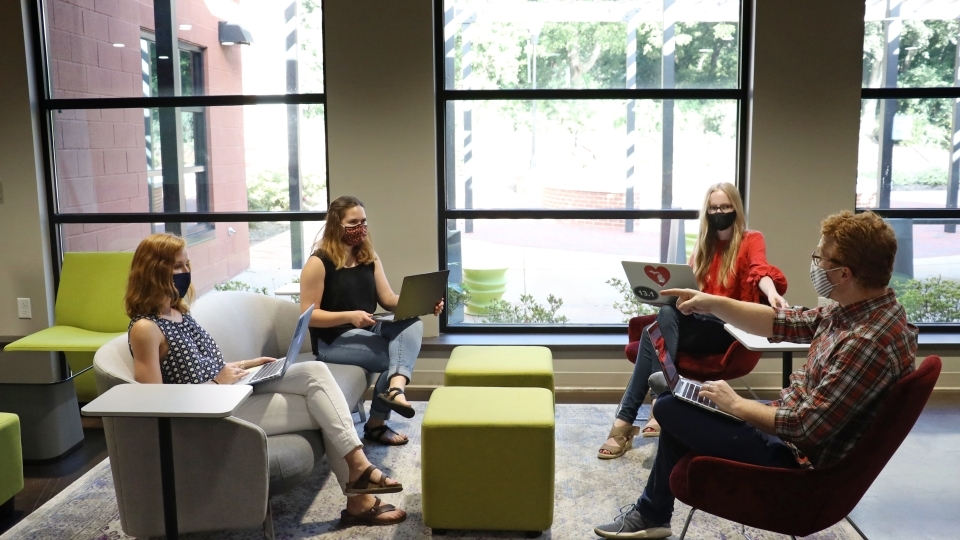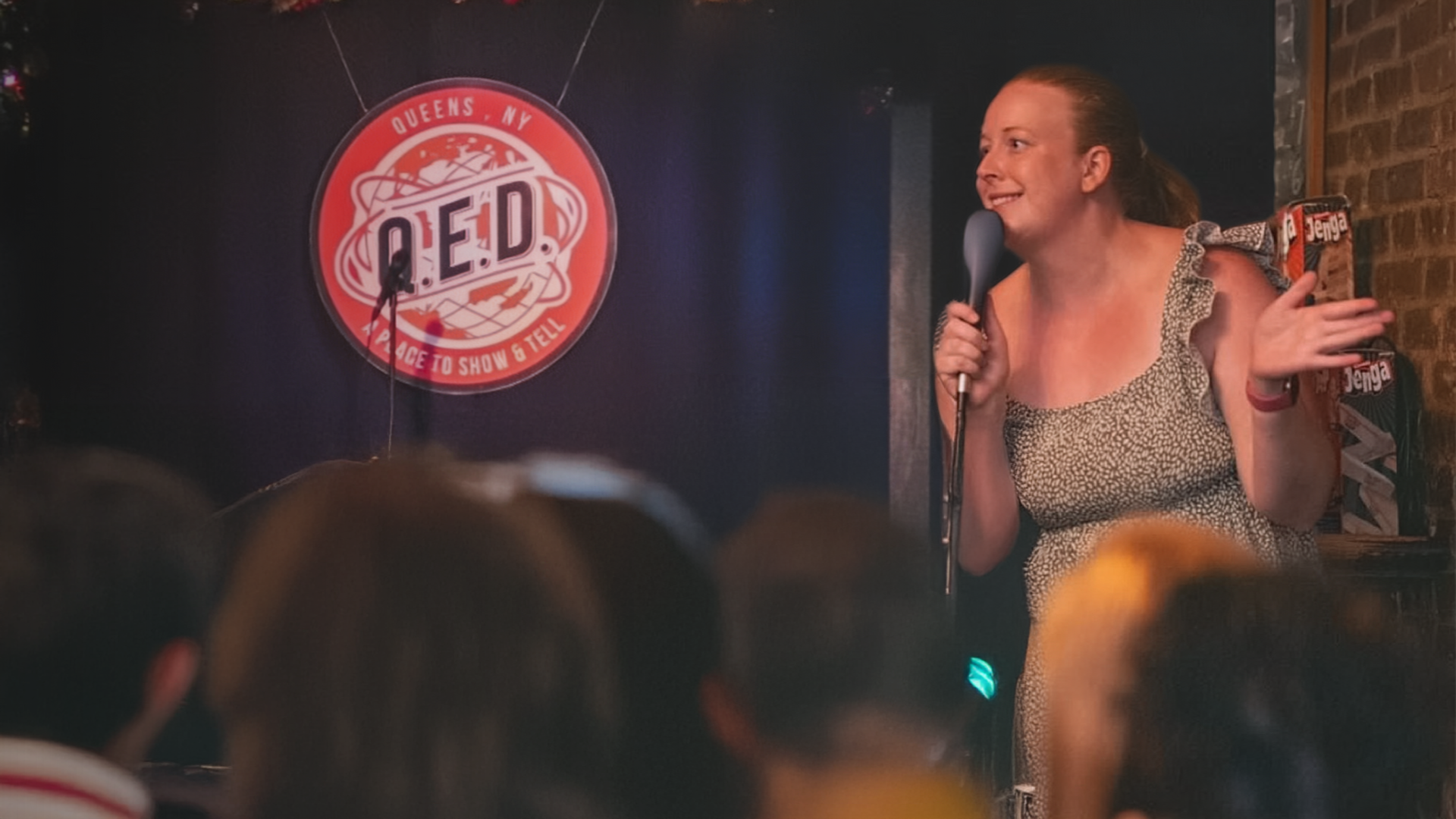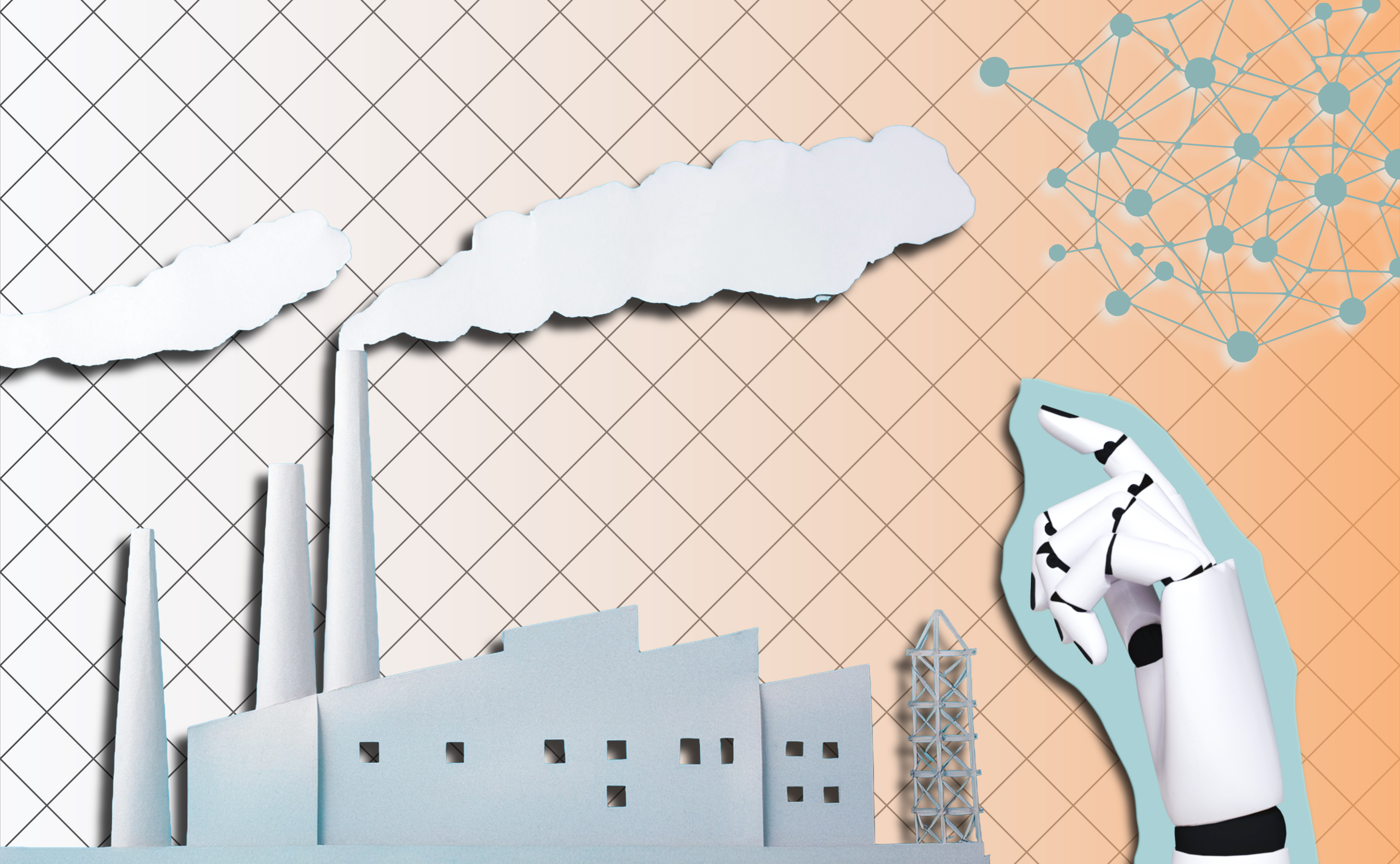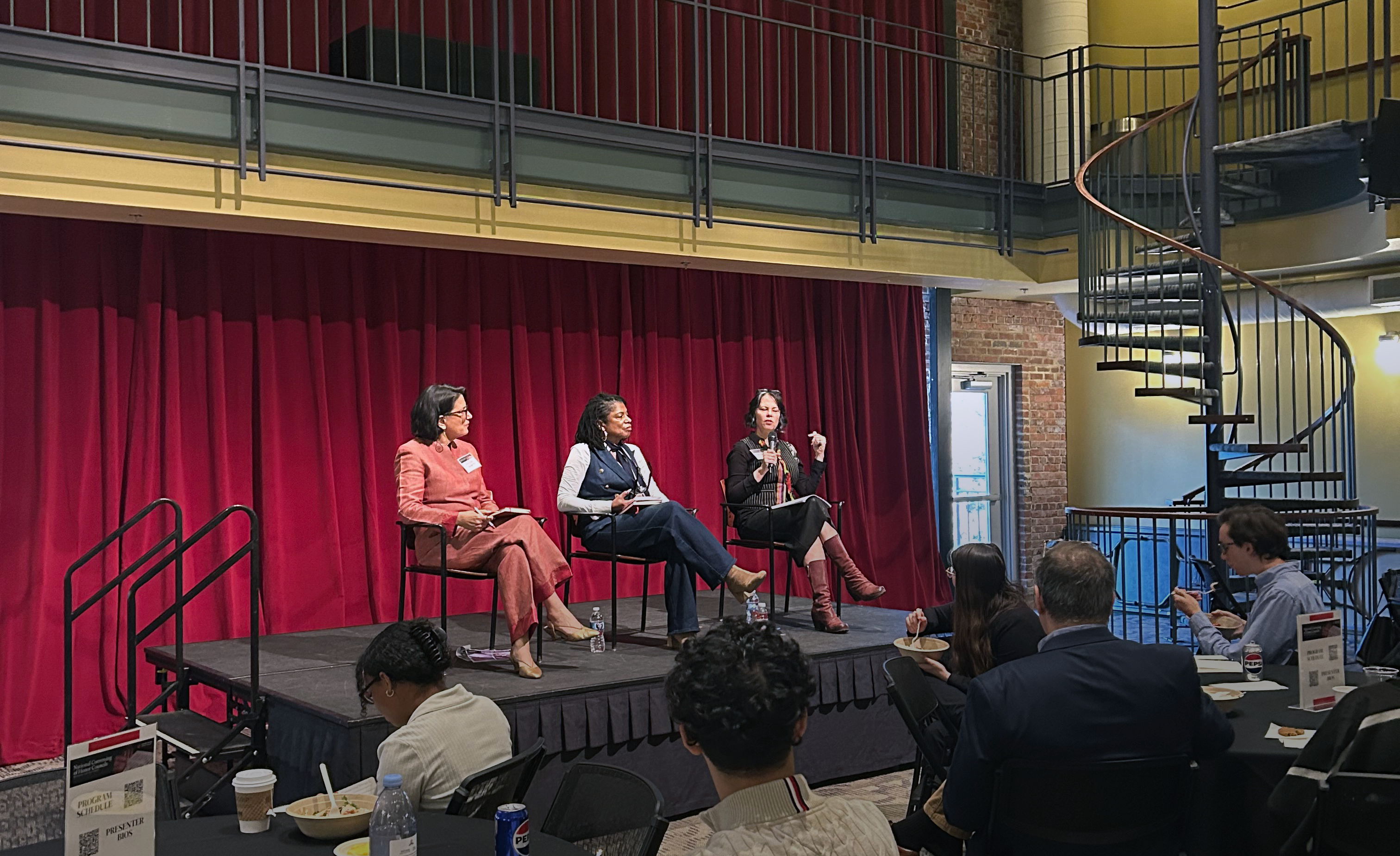Order to Crisis: Drive for Data Fuels In-demand Research Initiative
January 8, 2021
- Author
- Jay Pfeifer

Using data, Chris Marsicano (right) and his team of student researchers made sense of the extraordinary disruption the pandemic caused in higher ed.
On March 12, just hours after Davidson announced a shift to remote instruction, Maddie Buitendorp strolled down the hallways of Chambers Building, savoring her last moments on campus.
She wound up in room 3015, the office of Educational Studies Professor Chris Marsicano, who had tweeted that he’d be there for any students who wanted to talk.
Buitendorp ’22 and Mariscano knew each other well. She assisted Marsicano with research into higher education issues. As she sat down, a dispiriting thought shot through her mind.
“I realized the research I’d been working on was suddenly irrelevant,” she says.
Seniors Katie Felten and Luis Toledo—also research assistants for Marsicano—showed up, too.
“We were all unsure,” Toledo says. “For me, it was knowing that everything from that moment on was going to be different. I knew I wasn’t going to have a graduation. But I still wanted to work with this team that made Davidson feel like home, feel like I had a sense of community.”
That’s when the impromptu group therapy session turned into a group project.
They had no idea that their work would turn them into sought-after pandemic advisors—that their research would catapult them into news stories across the world and inform the rapidly changing pandemic response plans among colleges and universities, or that thousands of institutions and businesses that partner with higher ed would look to their research to navigate the new environment in schools from North Carolina to California.
On that dark night, it was just students and their professor talking things out.
“We asked, ‘How can we maintain our work of making the world a better place?’” Marsicano says. “And we said, ‘Let’s look at what’s happening right now. The world needs more info on how colleges are responding to the pandemic.’”
They left Marsicano’s office without a clear plan—that would come—but they knew that instead of fighting the tidal wave washing out the spring semester, they would swim with it. They would measure it. They would see what other schools were doing.
“We had three students who believe in Davidson in my office that night,” Marsicano says. “They wanted to do something. Within 48 hours, they had it: ‘Let’s collect data.’ And they wanted to do it for two reasons: One, it was a good idea. And two, it took our minds off of the situation.”
Chris Marsicano, Assistant Professor of the Practice in Educational Studies and 2010 Davidson graduate
New Trajectory
It wasn’t glamorous work. Felten, Toledo, Buitendorp and Marsicano checked thousands of schools’ websites and social media accounts for up-to-date coronavirus messaging. And because each institution’s website is different, there was no easily repeatable process.
“We originally thought we could get it done in five days,” Felten says. “Three weeks later, we finally finished.”
“I thought it would be something I could do with Netflix on in the background,” she says. “But by the end, I would turn everything off and just focus for hours.”
Yes, the work was occasionally mind-numbing, but it soaked up the free time that college students across the country were finding more of a curse than a blessing.
“My schedule was going to class, doing homework and then the rest of the time was data collection,” Toledo says. “Wherever I could fit it in—middle of the day, late at night. In a way, my job was this research, and I would fit in my classwork where I could.”
While the student researchers gathered tens of thousands of data points, Marsicano opened a Google doc and started writing.
“Four weeks after our first virtual meeting, we had a working paper,” he says.
That paper, “Tracking Campus Response to the COVID-19 Pandemic”—co-authored by Marsicano, Felten, Buitendorp and Toledo—quickly became the most-viewed preprint paper in the American Political Science Association’s history.
The attention not only validated their work, it launched them on a new trajectory. They had hit on something: A huge appetite for information about the disruption caused by the coronavirus.
“Being the most-downloaded paper was amazing,” Buitendorp says. “No one had seen this or been exposed to that kind of excitement. Reporters were calling. It was all over Twitter. People wanted the data. And that made it so real. All these hours on the web finally made sense. We weren’t just gathering data in our childhood bedrooms.”
National Partnerships
The paper caught the eye of John Barnshaw, vice president of research and data science for Ad Astra, a company that helps colleges build course schedules.
“Marsicano’s team did a masterful job of demonstrating how flexible and resilient higher education can be in fulfilling its mission to students and their communities,” Barnshaw says.
“I was so impressed with the paper that I reached out to Chris and over the course of the call, we realized we had so much in common interests that a partnership seemed like the next logical step.”
Ad Astra and Marsicano’s team partnered on a survey that went out to hundreds of registrars, expanding their reach and adding a crucial data set to their work.
Barnshaw says Ad Astra helped more than 500 higher education institutions transition to online-only operations. During that time, “we did not have much of a chance to take a breath and think systematically about this work and how we might better align with the broader needs,” he says. “It is great to be a part of a team that helps align our work with the ongoing needs of all institutions of higher education.”
At the same time, Marsicano’s team made a fortuitous on-campus connection with Laurie Heyer, Kimbrough Professor of Mathematics. Heyer leads Project PRONTO++ (PRoductive ONline TOols), a group of student data scientists and programmers who use their skills to solve real-world problems.
And they knew right away that they could turbocharge the Marsicano team’s work.
As Felten put it, “They looked at us as if our heads had fallen off after we told them how we gathered the data.”
They called in Jake Carver ’21, a computer science and English double major, who’d developed web crawler programs that automatically scan websites for information. His expertise saved the C2i data collectors immeasurable time.
Their task was easier said than done. The crawler had to be nimble enough to scan websites of massive state research universities and small liberal arts colleges—and everything in between. Carver and computer science majors Brad Shook ’22 and Nathan Little ’21, embraced the challenge.
“It was an amazing experience,” Carver says. “It expanded our boundaries of what we were comfortable doing. We became better programmers as a whole because we had a wide range of experience but had never put it all together. We had to think critically about what we should use at the right time.”
While Carver’s group streamlined data gathering, another team, led by Owen Bezick ’21 and Nathan Jordan ’22, created a dashboard that made the thousands of data points instantly understandable and customizable.
If the data was sheet music, Bezick and his team made it sing.
“The dashboard is absolutely essential to gleaning information and insight from the data,” Heyer says. “There would be much less excitement if people had to wade through this themselves, or there were just a few static graphs and charts.”
By mid-June, the combination of technology and timeliness had changed the ad hoc team of student researchers who came together in Marsicano’s office into something more permanent: The College Crisis Initiative, or C2i.
(And in late August, Bezick and Calvin Spencer ’21 used their newly developed skills to build the college’s official COVID-19 testing dashboard.)
Sharing Innovation
Marsicano—who graduated from Davidson with a political science degree in 2010—is a true believer in the liberal arts. It should come as little surprise when he points to Ferrara, a walled city an hour west of Venice, as inspiration for C2i. During the Black Death, Ferrara developed early models for contact tracing and thoughtful quarantine practices—and suffered no deaths from the disease.
“Ferrara innovated,” Marsicano says. “C2i can be like Ferrara by asking questions and sharing innovation among higher education institutions.”
By collecting and offering the data in real-time, C2i became a resource for institutions planning their next moves in response to the pandemic; and it will inform how the higher education sector responds to future crises.
“The uncertainty of COVID made information that was recent hugely valuable,” he says. “And it was truly one of those times when this data was not only useful; if we could help colleges plan more effectively, this data could actually save lives.”
The logo for C2i even pays homage to Ferrara, combining the city’s shield-shaped symbol with the colors of a stoplight.
C2i’s quick work attracted partners and sponsors. The Educational Credit Management Corporation Foundation, an influential higher ed funder, provided a $75,000 grant that allowed Marsicano to hire around 30 additional student researchers over the summer. That filled a critical need on the C2i team and also provided an opportunity for students at a time when internships and job offers withered in COVID-19’s wake.
It was the first of many partnerships. C2i became the exclusive provider of COVID-19 data for The Chronicle of Higher Education, higher ed’s premier trade publication.
Marsicano and the C2i researchers have become seasoned media voices, quoted in newspapers, magazines and websites around the world. The Wall Street Journal, Washington Post, and the Economist are frequent users of the C2i data. On multiple occasions this Fall, Marsicano made good use of his coffee grinder and French press, staying up late to do radio spots for the BBC World Service and a live TV hit for a Pakistani news outlet. But usually, he has the student researchers answer media questions.
It’s a strategy that underscores how much the students have grown from their experience—and from Marsicano’s deep faith in them.
“I have a friend who was shocked when I told her students were answering media questions,” Marsicano says. “But they are ready—and more than that, they were eager for the opportunity. I remembered how I felt as a senior at Davidson. I wanted to do important work. And even though it can be scary, the only way to conquer those nerves is to do it.”
Felten was quoted in Teen Vogue and on NPR, among others.
“I had moments where I took a call from a number I didn’t know—and it was USA Today. That on-the-spot questioning is intense but what better experience could there be to prepare for job interviews? They’re calling to ask for your opinion—that’s amazing,” says Felten, who started as a Consulting Analyst at Huron Consulting Group in September.
Next Steps
The C2i team still measures and shares higher education’s pandemic ups and downs in real time. They are also seizing opportunities to expand its focus. After all, there will always be new crises in higher ed, even when the pandemic is finally a thing of the past.
“Institutions of higher education are pretty conservative by nature,” Marsicano says. “They’re loathe to change unless there’s a reason.
“Well, now you’ve got a pandemic—the biggest reason in the world to change. But they don’t need to do it in a vacuum. We will stop focusing exclusively on COVID and more on crises in general.”
In September, for example, Buitendorp worked with a team of data collectors led by Emily Rounds ’21 to measure the impact of the California wildfires on schools on the west coast.
“Even when we’re done with COVID, we’ll keep working,” she says. “My goal is to make C2i invaluable to Davidson. If we had more time and more funding, we would expand into other areas. We want data that can shape higher ed for the better, data that can lead to positive change.”
Though it’s only been a few months since they founded C2i, Felten, Toledo and Buitendorp already speak about the project as the culmination of their education.
“C2i taught me to step back and look at the big picture,” says Toledo, now a Colby College admissions counselor. “It’s really special; that at Davidson we can be in a community where we can learn together. There’s that a-ha moment at Davidson, where you gather your knowledge; and you see how your corner of academia fits into the world. C2i was that moment for me.”
For Marsicano, the growth of the C2i student team has been his own dream come true.
“Every professor wants to do two things: Attend a student’s wedding and see our students apply what they learned. I’ll get to the weddings in time—but this was thrilling because I could see them growing and putting their skills to work.”
This article was originally published in the Fall/Winter 2020 print issue of the Davidson Journal Magazine; for more, please see the Davidson Journal section of our website.



